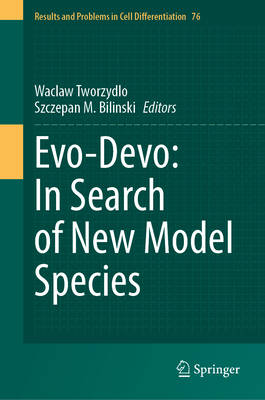
- Afhalen na 1 uur in een winkel met voorraad
- Gratis thuislevering in België vanaf € 30
- Ruim aanbod met 7 miljoen producten
- Afhalen na 1 uur in een winkel met voorraad
- Gratis thuislevering in België vanaf € 30
- Ruim aanbod met 7 miljoen producten
Zoeken
Evo-Devo: In Search of New Model Species
€ 335,95
+ 671 punten
Omschrijving
The field of evolutionary developmental biology (Evo-Devo) has been profoundly shaped by a handful of classical model organisms -- such as Drosophila melanogaster, Caenorhabditis elegans, zebrafish, mouse, and Arabidopsis -- which have provided fundamental insights into the genetic and molecular mechanisms underlying development. However, relying solely on these few models has also imposed epistemological and practical limitations, particularly when it comes to addressing the diversity of developmental processes and evolutionary trajectories found across the tree of life. As Evo-Devo matures, there is a growing recognition of the need for new model systems that better capture the breadth of evolutionary innovations, ecological contexts, and phenotypic plasticity. This volume continues to advocate the use of strategically diversified model systems as tools for filling existing gaps. It also explores the philosophical, methodological and practical considerations in the search for new model species in Evo-Devo, highlighting recent successes, ongoing challenges, and the full potential of expanding the repertoire of model species. The book offers readers a fresh perspective on developmental processes and their natural diversity among different animal groups, fostering a deeper understanding. It broadens the horizons of experienced researchers and those just starting out in the field.
Specificaties
Betrokkenen
- Uitgeverij:
Inhoud
- Aantal bladzijden:
- 282
- Taal:
- Engels
- Reeks:
- Reeksnummer:
- nr. 76
Eigenschappen
- Productcode (EAN):
- 9783032067654
- Verschijningsdatum:
- 1/01/2026
- Uitvoering:
- Hardcover
- Formaat:
- Genaaid
- Afmetingen:
- 155 mm x 235 mm

Alleen bij Standaard Boekhandel
+ 671 punten op je klantenkaart van Standaard Boekhandel
Beoordelingen
We publiceren alleen reviews die voldoen aan de voorwaarden voor reviews. Bekijk onze voorwaarden voor reviews.







